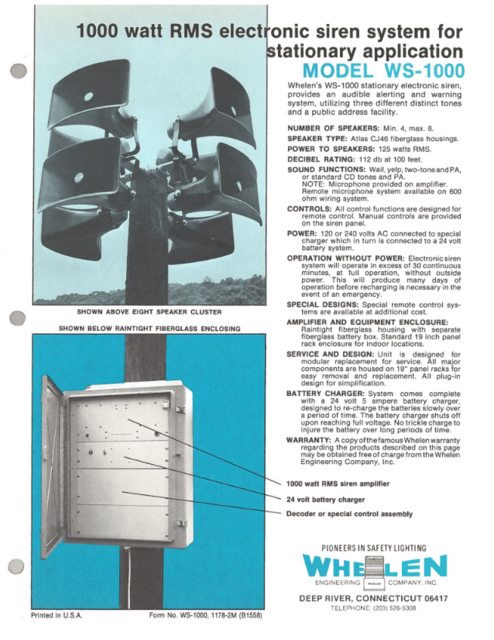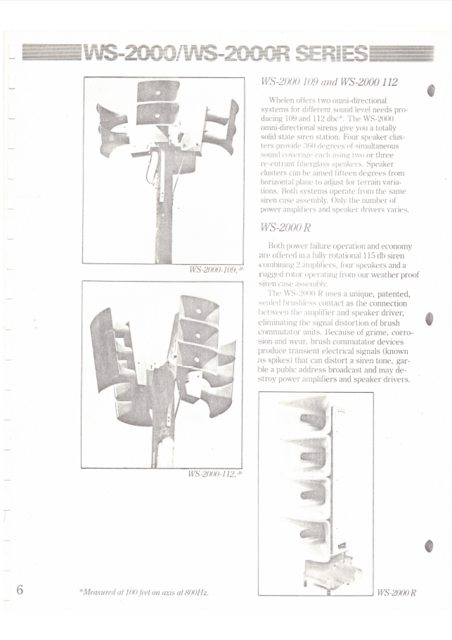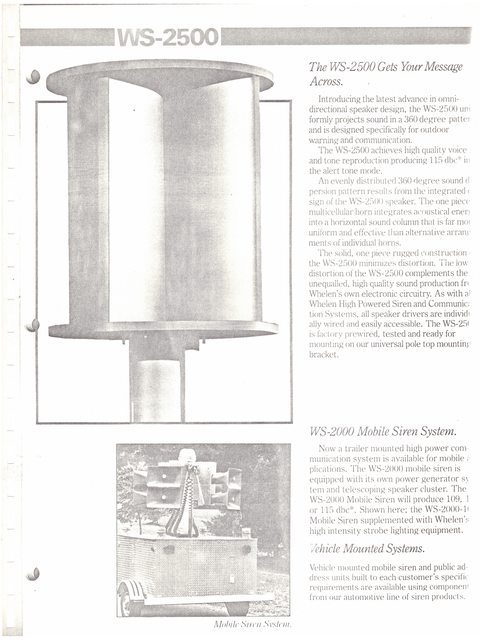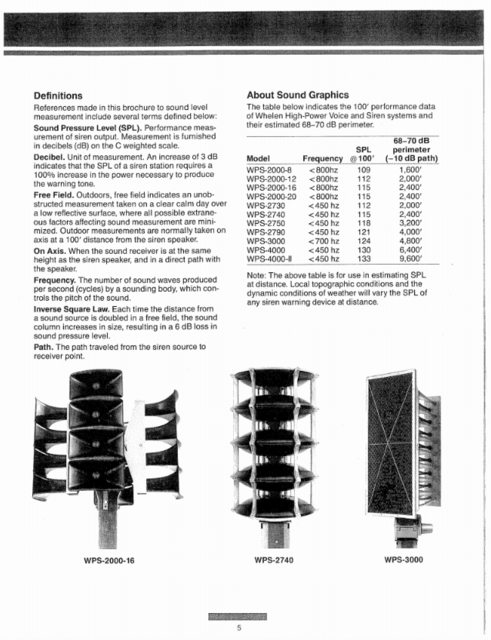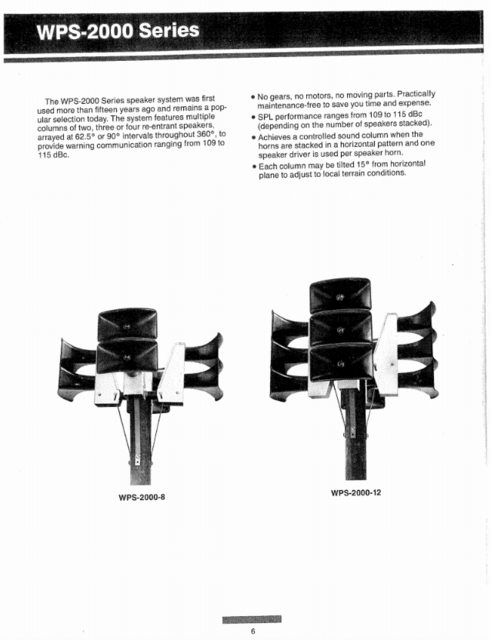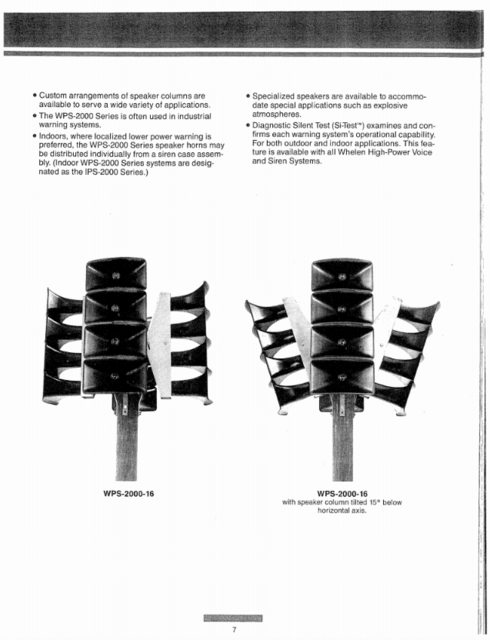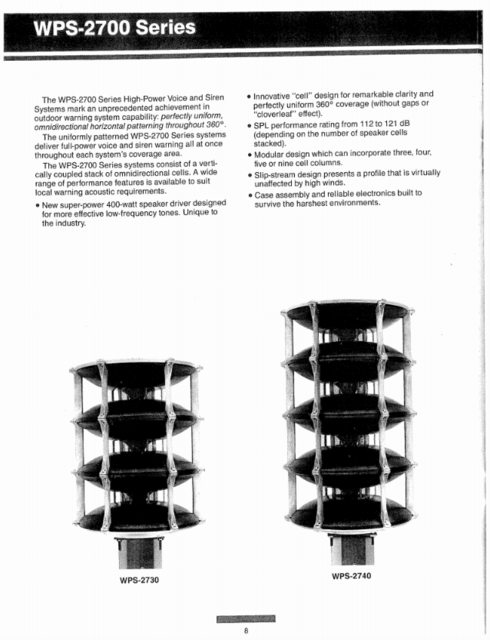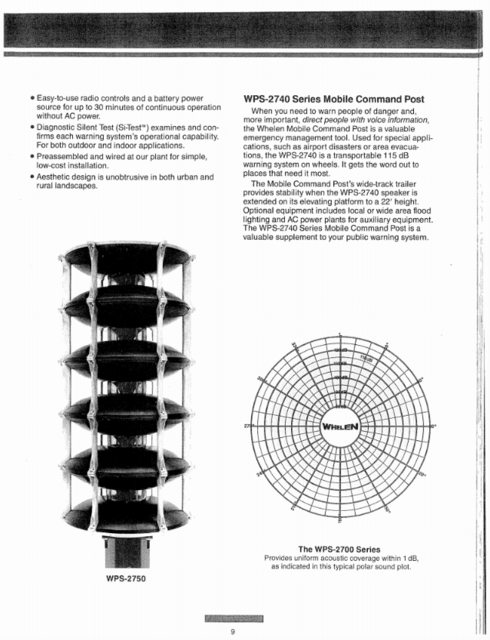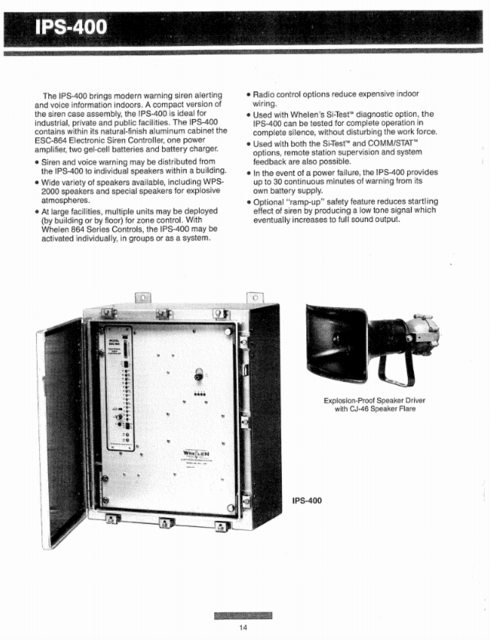Whelen Engineering: Difference between revisions
(Added more. Still more to come.) |
(Much more. More to still come.) |
||
| Line 62: | Line 62: | ||
Not long after the introduction of these two sirens, likely around the debut of the 3000, the model nomenclature was changed to reflect the number of speakers instead of siren output. This resulted in the WS-2000-8, 2000-12, 2000-16, and 2000-20, with the 2000-20 being the aforementioned twenty-speaker 2500. Not much changed until 1987, when the series received the “WPS” prefix. The IPS-2000 series was introduced as an indoor version of the WPS-2000. Multiple variations of siren speakers, including the 2000 series speakers as well as an explosion-proof variant, would be placed around a building and it would all route into a central IPS-400 control cabinet. This allowed for zone, group, and individual control of each speaker. Also notable, a “ramp-up” safety feature was available wherein the siren wind up would start at a lower output and increase to full, as to not startle the occupants in the building. More importantly, the WPS-2700 series was introduced the same year. Designed by Bruce Howze, the 2700 series utilized individual fiberglass “speaker cells”, wherein sound would be reflected onto two curved surfaces and thrown horizontally in a true 360-degree pattern. Each cell was held together by aluminum brackets. The 2700 series also introduced Whelen’s 400-watt “superpower” drivers, again designed by Bruce Howze along with his company Community Pro Loudspeakers. The 2700 was offered in three, four, five, and nine speaker cell arrangements being the 2730, 2740, 2750, and 2790 respectively. Each output area would include a mesh screen, as to prevent dirt and wildlife from decreasing sound output. Also available was the WPS-2740 Series Mobile Command Post, which consisted of a WPS-2740 mounted atop a hydraulic platform atop a trailer. | Not long after the introduction of these two sirens, likely around the debut of the 3000, the model nomenclature was changed to reflect the number of speakers instead of siren output. This resulted in the WS-2000-8, 2000-12, 2000-16, and 2000-20, with the 2000-20 being the aforementioned twenty-speaker 2500. Not much changed until 1987, when the series received the “WPS” prefix. The IPS-2000 series was introduced as an indoor version of the WPS-2000. Multiple variations of siren speakers, including the 2000 series speakers as well as an explosion-proof variant, would be placed around a building and it would all route into a central IPS-400 control cabinet. This allowed for zone, group, and individual control of each speaker. Also notable, a “ramp-up” safety feature was available wherein the siren wind up would start at a lower output and increase to full, as to not startle the occupants in the building. More importantly, the WPS-2700 series was introduced the same year. Designed by Bruce Howze, the 2700 series utilized individual fiberglass “speaker cells”, wherein sound would be reflected onto two curved surfaces and thrown horizontally in a true 360-degree pattern. Each cell was held together by aluminum brackets. The 2700 series also introduced Whelen’s 400-watt “superpower” drivers, again designed by Bruce Howze along with his company Community Pro Loudspeakers. The 2700 was offered in three, four, five, and nine speaker cell arrangements being the 2730, 2740, 2750, and 2790 respectively. Each output area would include a mesh screen, as to prevent dirt and wildlife from decreasing sound output. Also available was the WPS-2740 Series Mobile Command Post, which consisted of a WPS-2740 mounted atop a hydraulic platform atop a trailer. | ||
[[File:Whelen19881.jpeg]] | |||
[[File:Whelen19882.jpeg]] | |||
[[File:Whelen19883.jpeg]] | |||
Several pages of a 1988 Whelen Systems brochure, showcasing the WPS-2000, WPS-2700, and WPS-3000 series sirens. Note that there is no mention of a single row 2000 model. | |||
[[File:Whelen19884.jpeg]] | |||
[[File:Whelen19885.jpeg]] | |||
[[File:Whelen19886.jpeg]] | |||
A few more pages from the same brochure, showcasing the WPS-2700 series and IPS-400 indoor system. | |||
The WPS-2700 series ultimately superseded the WPS-2000 series in both design and popularity, and the WPS-2000 series went out of production in 1990. (Something that should be noted: a WS and/or WPS-2000-4 was offered at some point, but there is little to no mention in any documentation.) However, the 2700 series would soon follow. In 1991, the 2700 series was retired and replaced with the improved 2800 series. Not only did it introduce a full fiberglass housing, but it expanded on the modular principle of the 2700, adding six new variants. Not to mention, the mesh screen was enlarged to cover a wider radius around the siren output. The 2800 series was available in a one to ten speaker cell arrangement, as the WPS-2800-1, 2800-2, 2800-3, 2800-4, 2800-5, 2800-6, 2800-7, 2800-8, 2800-9, and 2800-10. The 2800 saw wide use across the United States and abroad during its long production run of 15 years. | |||
[[Category:Siren Manufacturers]] | [[Category:Siren Manufacturers]] | ||
Revision as of 16:51, 11 April 2019
| Whelen Engineering |
The text in this article is written in 1st person by 4J25, that will likely change later.
A brief history of their outdoor warning sirens.
Important: Text that is bolded refers to information that has been inferred. Essentially, this is information for which I have been unable to find concrete evidence, but related topics and other information strongly suggests that it should be correct, or if it's almost painfully obvious.
I've attempted to organize this information by each siren series, and chronologically within each series. With that said, there are a few things you ought to know now:
The Controllers
From 1977 to 1987, the controller on each Whelen siren consisted of a separate tone generator and decoder. Any siren using this form of controller contains the prefix "WS" in the model nomenclature. In 1987, the microprocessor based ESC-864 was introduced. Any siren with this controller or newer or any older siren that has received a front panel upgrade contains the prefix "WPS" in the model nomenclature. Contrary to popular belief, "WS" and "WPS" don't actually stand for anything. In 1993, the ESC-864 was upgraded from analog to digital. In 2001, the ESC-864 was replaced with the ESC-2020. Around 2011 or 2012, the ESC-2020 was replaced with the ESC-2030, which is in production at the time of this post.
Bruce Howze and Community Pro Loudspeakers
You will see the name Bruce Howze mentioned a bit. Mr. Howze, along with his company Community Pro Loudspeakers, designed a multitude of Whelen sirens and parts. Howze and CPL are an integral part of Whelen's history, and they still supply their 400-watt "superpower" drivers.
An Organizational Sidenote
I have opted to include the Vortex under the 4000 series section, similar to how the Vortex-O would be considered part of the 2000 series.
With that said, let's talk sirens!
WS-1000
Whelen Engineering first entered the outdoor warning siren market in 1977, with their WS-1000 siren. While capable of three distinct signals (wail, yelp, and two-tone) and voice functionality, the primary feature introduced by the 1000 was its battery backup—the first of its kind on the market. The siren head itself was of a rather simple design: four* to eight 125-watt drivers, each routed through Atlas CJ46 re-entrant fiberglass paging horns, all attached to a utility pole. Despite being Whelen’s revolutionary introduction to the outdoor warning siren market, the 1000 never seemed to be too popular, and it ended up having a relatively short production run, ending in 1979.
This advertisement from 1978 depicts an 8-speaker WS-1000.
A few locations known to have/have had WS-1000s: Owensboro, KY Winona Lake, IN Mount Pleasent, MI
- A few WS-1000 sirens have been found with less than 4 speakers, however it appears that the minimum was intended to be 4.
2000 Series
Luckily, Whelen had a siren lined up to replace it. The WS-2000 series was introduced in late 1979. It took the simplicity of the 1000 and installed it in a more streamlined and efficient package. The 2000 series sirens used the same CJ46 re-entrant horns, however, this time they were arranged vertically along an aluminum “column” and used 100-watt drivers. Each column was on a pivot and could be tilted downwards. Initially, eight, twelve, and sixteen-speaker models were available, being the WS-2000-109, WS-2000-112, and WS-2000-115 respectively. Over the next few years, two additional sirens would be introduced to the 2000 series line: the WS-2000R and the prototypical WS-2500, Whelen’s first “true” 360-degree omnidirectional siren. The original 2500 design, drawn up by Bruce Howze in 1981, would never see actual production, and it was absorbed into the 2000 series line as a twenty-speaker siren. The 2000R was a four-speaker rotational/directional siren. It consisted of four CJ46 horns attached to a rectangular aluminum body that sat atop a rotor. Unlike the 3000 series sirens introduced around the same time, the 2000R utilized a sealed brushless contact to connect the siren head with the controller. This allowed the siren to rotate a full 360 degrees. Some 2000Rs, most notably those in St. Louis, Missouri, also included a mesh screen inside the horns. The 2000R was a very short run, and it was not a very popular siren.
Early 80s brochure pages showcasing the early 2000 series, including the 2000R and then-prototypical 2500.
Not long after the introduction of these two sirens, likely around the debut of the 3000, the model nomenclature was changed to reflect the number of speakers instead of siren output. This resulted in the WS-2000-8, 2000-12, 2000-16, and 2000-20, with the 2000-20 being the aforementioned twenty-speaker 2500. Not much changed until 1987, when the series received the “WPS” prefix. The IPS-2000 series was introduced as an indoor version of the WPS-2000. Multiple variations of siren speakers, including the 2000 series speakers as well as an explosion-proof variant, would be placed around a building and it would all route into a central IPS-400 control cabinet. This allowed for zone, group, and individual control of each speaker. Also notable, a “ramp-up” safety feature was available wherein the siren wind up would start at a lower output and increase to full, as to not startle the occupants in the building. More importantly, the WPS-2700 series was introduced the same year. Designed by Bruce Howze, the 2700 series utilized individual fiberglass “speaker cells”, wherein sound would be reflected onto two curved surfaces and thrown horizontally in a true 360-degree pattern. Each cell was held together by aluminum brackets. The 2700 series also introduced Whelen’s 400-watt “superpower” drivers, again designed by Bruce Howze along with his company Community Pro Loudspeakers. The 2700 was offered in three, four, five, and nine speaker cell arrangements being the 2730, 2740, 2750, and 2790 respectively. Each output area would include a mesh screen, as to prevent dirt and wildlife from decreasing sound output. Also available was the WPS-2740 Series Mobile Command Post, which consisted of a WPS-2740 mounted atop a hydraulic platform atop a trailer.
Several pages of a 1988 Whelen Systems brochure, showcasing the WPS-2000, WPS-2700, and WPS-3000 series sirens. Note that there is no mention of a single row 2000 model.
A few more pages from the same brochure, showcasing the WPS-2700 series and IPS-400 indoor system.
The WPS-2700 series ultimately superseded the WPS-2000 series in both design and popularity, and the WPS-2000 series went out of production in 1990. (Something that should be noted: a WS and/or WPS-2000-4 was offered at some point, but there is little to no mention in any documentation.) However, the 2700 series would soon follow. In 1991, the 2700 series was retired and replaced with the improved 2800 series. Not only did it introduce a full fiberglass housing, but it expanded on the modular principle of the 2700, adding six new variants. Not to mention, the mesh screen was enlarged to cover a wider radius around the siren output. The 2800 series was available in a one to ten speaker cell arrangement, as the WPS-2800-1, 2800-2, 2800-3, 2800-4, 2800-5, 2800-6, 2800-7, 2800-8, 2800-9, and 2800-10. The 2800 saw wide use across the United States and abroad during its long production run of 15 years.
